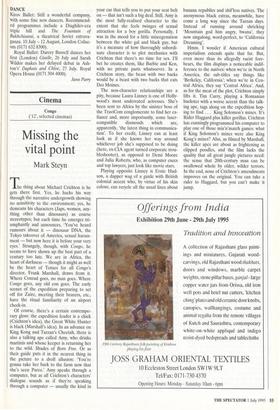Cinema
Congo (`12', selected cinemas)
Missing the vital point
Mark Steyn
The thing about Michael Crichton is he gets there first. Yes, he hacks his way through the narrative undergrowth showing no sensitivity to the environment; yes, he demeans his characters (Japs, women, any- thing other than dinosaurs) as coarse stereotypes; but each time he emerges tri- umphantly and announces, 'You've heard rumours about it — dinosaur DNA, the Tokyo takeover of America, sexual harass- ment — but now here it is before your very eyes.' Strangely, though, with Congo, he seems to have shown up the best part of a century too late. We are in Africa, the heart of darkness — though it might as well be the heart of Totnes for all Congo's director, Frank Marshall, draws from it. Where Conrad goes, no man goes. Where Congo goes, any old con goes. The early scenes of the expedition preparing to set off for Zaire, meeting their bearers, etc., have the ritual familiarity of an airport check-in.
Of course, there's a certain contempo- rary gloss: the expedition leader is a chick (Crichton's idea), the Great White Hunter is black (Marshall's idea). In an advance on King Kong and Tarzan's Cheetah, there is also a talking ape called Amy, who drinks martinis and whose keeper is returning her to the wild. Shades of Born Free. Or as their guide puts it in the nearest thing in the picture to a droll allusion: 'You're gonna take her back to the farm now that she's seen Paree.' Amy speaks through a computer, but as all Crichton's characters' dialogue sounds as if they're speaking through a computer — usually the kind in
your car that tells you to put your seat belt on — that isn't such a big deal. Still, Amy is the most fully-realised character to the extent that she feels twinges of sexual attraction for a boy gorilla. Personally, I was in the mood for a little miscegenation between the white gal and black guy, but it's a measure of how thoroughly subordi- nate character is to plot mechanics with Crichton that there's no time for sex. I'll bet he creates them, like Barbie and Ken, with no private parts whatsoever. In a Crichton story, the beast with two backs would be a beast with two backs that eats Des Moines.
The non-character relationships are a pity, because Laura Linney is one of Holly- wood's most underrated actresses. She's been sent to Africa by the sinister boss of the TraviCom conglomerate to find her ex- fiancé and, more importantly, some laser- compatible diamonds which are, apparently, 'the latest thing in communica- tion'. To her credit, Linney can at least look as if she knows her way around whichever job she's supposed to be doing (here, ex-CIA agent turned corporate trou- bleshooter), as opposed to Demi Moore and Julia Roberts, who, as computer execs and top lawyers, just look like movie stars.
Playing opposite Linney is Ernie Hud- son, a dapper wag of a guide with British colonial accent who, by virtue of his skin colour, can recycle all the usual lines about banana republics and shif'less natives. The anonymous black extras, meanwhile, have come a long way since the Tarzan days. Instead of running around shrieking `Mountain god him angry, bwana', they now singalong, word-perfect, to 'California Dreaming'.
Hmm. I wonder if American cultural imperialism extends quite that far. But, even more than its allegedly racist fore- bears, the film displays a noticeable indif- ference to the natives: when we're in North America, the sub-titles say things like `Berkeley, California': when we're in Cen- tral Africa, they say 'Central Africa'. And, as for the meat of the plot, Crichton simply lifts it. Tim Curry, playing a Romanian huckster with a worse accent than the talk- ing ape, tags along on the expedition hop- ing to find . . . King Solomon's mines. It's Rider Haggard plus killer gorillas. Crichton has cunningly programmed his computer to play one of those mix'n'match games: what if King Solomon's mines were also King Kong's mines? Alas, as filmed by Marshall, the killer apes are about as frightening as clipped poodles, and the film lacks the quality that all great jungle pictures need: the sense that 20th-century man can be swallowed whole by older, wilder terrors. In the end, none of Crichton's amendments improves on the original. You can take a rider to Haggard, but you can't make it jump.


































































 Previous page
Previous page